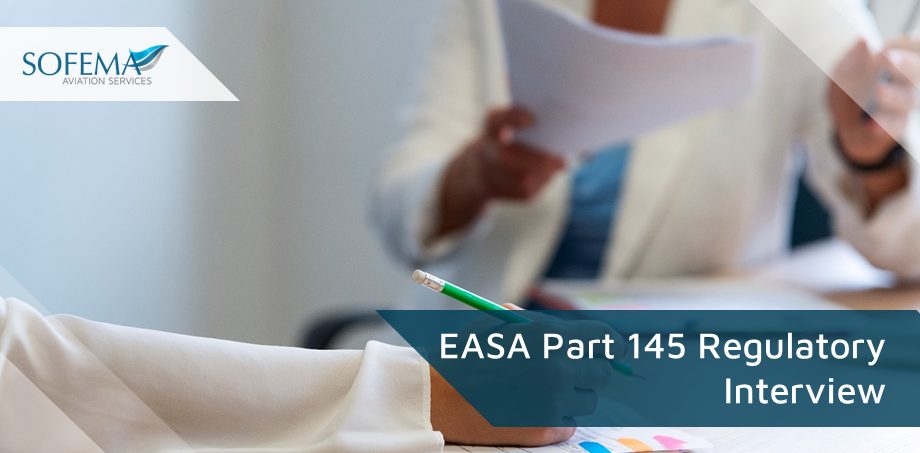Sofema Aviation Services (SAS) www.sassofia.com has been delivering regulatory training and consultancy for over 15 years, and over 100,000 delegates have enrolled in our training. The purpose of this document is to help you prepare for an EASA Part 145 Regulatory interview – the difficulty can range from extremely straightforward to almost impossible based on a simple understanding of the role of EASA or any other inspector for that matter.
Who is the Subject of the EASA Part 145 Regulatory Interview
– Accountable Manager
– Nominated Personnel
– Maintenance Manager,
– Compliance Monitoring Manager
– Safety Manager
– Certifying Staff.
Is there a magic list of questions that our client can prepare? – Essentially NOT! (Note for simplicity please accept his/him as meaning he/she him/her)
Careful Note – If you are not prepared there is always a potential for an interview to fall apart! – Why? (Because the EASA Inspector is viewing things in a slightly different way to maybe what you expect)
– He is looking for a demonstration of confidence in the ability of the interviewee regarding overall competence and general (not specific knowledge) – means I know my role, obligations and responsibilities but possibly not every nuance of the actual process and procedures. But I do know exactly where to find the information for a given subject – sure in general I know what is required and how to comply, but it is not a memory test and I prefer to check the information to know I am correct.
Before you go any further please consider in details the following terms.
– Can you explain the difference between Quality Assurance & Quality Control? (in details – means who is the owner of each how is it measured and managed in each case – how does oversight and reporting work)
– What is the difference between a Hazard and a Risk – how should each be addressed – what is the process for reporting, analyzing and mitigating?
– What is the difference between Quality Assurance and Safety Assurance – How does your organization engage in Safety Assurance Activities – can you provide examples?
-Special note – Business Area owners are responsible for SMS & QC can you explain what this means in your case?
Consider the following as a guide which is actually relevant to every position (Each Role being Interviewed)
1/ Does the mentioned person fully understand his Role and Responsibility
- Means what are your duties and how can you demonstrate the necessary competence for each responsibility.
2/ Where is it written down in the company documentation?
- Are you fully aware of your documented responsibilities?
- Are you aware of the Safety and Quality Policy? (could you explain in general terms?)
- Are you aware if the Reporting Process (could you explain in general terms?)
3/ Where is your role written down in the aviation regulations? (is it in alignment with your company procedures? – what would you do if it was not?)
5/ Who do you report to? – What are the reporting requirements – Task Related – Process Related and Issue Related)
6/ Who reports to you? – What information does he receive? how does he validate this information, how do you validate this information. (Means how do you manage and support him?)
7/ How is the competence managed regarding anyone who reports to you – Are you familiar with the process (even you do not own the competence process can you validate it)
Regarding Quality
The Quality Auditing Department Should have evidence of Audits carried out across the business
- Real audits which show compliance with the regulations as well as compliance with the internal process & procedures
- Audits should look at the level of non-conformities across the business as this is an indication of health.
- Audits should also look at the competence management process in details
Very important note – if an external auditor /inspector / EASA finds anything wrong it means 2 things
o The first is that the business area owner who is responsible for QC has failed to ensure compliance.
o The second is that the Quality Auditor has failed to identify the non compliance
So essentially this is a double failure – means belt & braces have both failed.
In an effective well run organization QA should find little if any findings
Regarding Safety
- How can you show me the effectiveness of the Safety System in your organization
- What is the reporting level across the business – is this in line with your expectations – Why
- How does Safety benefit from Quality Assurance Data – note a Quality Finding typically generates multiple Safety related questions (could you give me an example of this)
Next Steps
Follow this link to our Library to find & Download related documents for Free. For comments or questions please email team@sassofia.com
Sofema Aviation Services www.sassofia.com and Sofema Online www.sofemaonline.com provide EASA regulatory compliant & vocational training please see the websites or email team@sassofia.com
Tags:
Accountable Manager, Certifying Staff, Compliance Monitoring Manager, EASA Inspector, EASA Part 145 Regulatory Interview, Maintenance Manager, Nominated personnel, Quality Assurance, Quality Assurance Data, Quality Auditing Department, Quality Auditor, Quality Control, Reporting Process, Safety Assurance Activities, Safety Manager, SAS blogs, SAS Library




